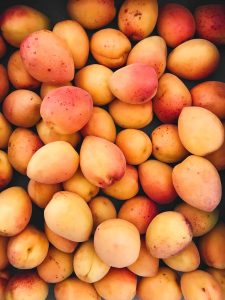Apricot jam
For some reason, apricots are one of those fruits that come and go in the blink of an eye. They come on fast and furious, and you have a very short window of time to deal with an overabundant bounty. Jam is a great way to use up a surplus of fruit. In this case, finding overripe ones are even better. The fruits may look past their prime, but at this stage, they are sweeter and perfect for making jam. You might even find them discounted at the store or farmers’ market.
The Science
According to a study in the journal of Food Chemistry, organic apricots have significantly higher levels of polyphenol and carotenoid antioxidants than conventional apricots. But, beware if you have an allergy to apricots: organic apricots have more bioactive compounds overall, including allergenic proteins.
The Recipe
 photo credit: Brigitte Tohm
photo credit: Brigitte Tohm
Equipment
- Sterilized canning jars of your size preference, with rings and fresh seals
- Large pot to shallow boil your jars
- Large pot to cook your fruit
- Best if you have a canning kit that includes a funnel and tongs to pull hot jars out of the pot
- Baking sheet
- Ladle (very important)
- Hammer
Ingredients
- Apricots
- Sugar
- optional: lemon juice
Cooking Directions
- The general ratio for jam 1:1 weight or volume of fruit to sugar. This produces a very sweet jam. If you prefer your jam on the less sweet side, then taste the fruit first to see how sweet or tart it is before deciding how much sugar to add. You can get away with as little as half as much sugar to fruit, or in other words 2:1 ratio of fruit to sugar. This ratio results in what is considered more of a conserve than a jam. And you can optionally squeeze a lemon or two into the pot for some acidity.
- Sterilize your glass jars and seals in boiling water for 3 minutes. Set aside on a cookie sheet.
- Cut the apricots in half and remove the pits, saving a handful of the pits (this is optional).
- Optional: Wrap the saved pits in a towel and use a hammer to crack them open and reveal the little almond seedthat is inside. Only use whole almond seeds, discard broken ones. The seeds add a nice bitter almond flavor to the jam, but biting into a whole one is pretty intense, so leaving them whole allows you to avoid eating them.
- Roughly chop the apricots and put them into a pot with the sugar. Bring the fruit and sugar to a boil and then reduce to a simmer.
- With a ladle, skim off any impurities that foam up on the surface. This helps keep your jam clear. Make sure to stir often so the jam does not burn on the bottom.
- Keep a little plate in the freezer to test when the jam is done by putting a small spoonful on the cold plate so that it can set quickly. It’s ready to be jarred when the spoonful no longer runs all over the plate when tipped. The jam should have reduced in volume by at least 1/3 at this point. The longer you cook it, the thicker the end product will be.
- While the jam is still hot, carefully fill the jars (the canning funnel is a helpful tool with this). Make sure the rims of the jars are clean. Wipe with a wet paper towel to remove debris before placing the seals on the jars. Loosely screw on the rings.
- Let the jam cool in the jars. The heat will seal the jars and create an airtight suction. You’ll know they are sealed when you push on the seal and it does not pop back at you. Once cool, you can further tighten the rings for storage.
Banner Photo Credit: Jinomono Media; unsplash.com


